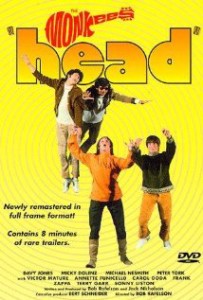An American in Paris
[DVD]

view/request
An American in Paris has long been one of my favorite films. Gene Kelly stars as Jerry, a charming if somewhat overly persistent American artist living in Paris. Oscar Levant plays another American, Jerry’s grouchy but endearing pianist friend Adam, and Georges Guetary plays the part of Henri, a French musical star who is friends with the two Americans. Adam and Jerry are perpetually broke, Jerry because he can’t sell his paintings and Adam because he hasn’t worked in years (he describes himself as the world’s oldest child prodigy). Many of the most charming scenes in the film take place in around the little cafe above which Adam and Jerry both live and which Henri frequently visits.
Early in the film Jerry meets the rich Milo Roberts (Nina Foch), whose professional interest in his work is a thin disguise for her hopes for romance. Jerry reluctantly accepts her patronage, but romantically he is more interested in Lise (Leslie Caron in her first film role), a young woman who, with time, becomes equally drawn to him but who is, though Jerry doesn’t know it, already engaged to Henri.
While the plot of the film is driven by these romances, the spirit of the film is driven by the music of George Gershwin. Gershwin’s music is used throughout the film: all of the songs are by George and Ira, the music for the sixteen minute ballet is an arrangement of Gershwin’s An American in Paris, and the remainder of the score draws heavily on these and other Gershwin compositions. We hear strains of Rhapsody in Blue and during a memorable dream sequence we are treated to a performance of the Concerto in F for Piano and Orchestra in which Adam performs not just on the piano, but on all the other instruments as well.
—And, of course, the dancing. The dancing in this film is incredible. The performances, the choreography, the costumes—there is no aspect of these dances that fails to impress. Gene Kelly and Leslie Caron are a perfect match; it is hard to imagine any other two dancers pulling off the required athletic grace or the perfectly balanced blend of ballet and popular dance styles showcased so well in this film. From the good spirited cheer of I’ve Got Rhythm and By Strauss to the sarcastic mocking of This Time It’s Really Love, and the earnest romance Our Love Is Here to Stay, to the passionate and diverse American in Paris ballet, these are dances you will remember and want to see again.
Reviewed by Ben
Tagged: Dance, Feature film, Musicals
Head
by Bob Rafelson
[DVD]

view/request
Head is a psychedelic, non-linear motion picture starring… THE MONKEES. While not participating in a traditional narrative, the film retains a cyclical structure. Cyclical, in this instance, by that one can take nearly any scene, rearrange it and the action will still relate and have meaning in its new place. Bob Rafelson, a co-creator of the Monkees television series, made his feature directorial debut with 1968’s Head. He co-wrote the film with the then obscure Roger Corman school B-movie actor Jack Nicholson.
Rafelson and Nicholson sought to tell the Monkees story and the complexities of instant fame in an abstract fashion while also exploiting as many genres as possible. It poses the question, “well, what is Head?” A musical? A western? A horror film? A comedy? A boxing story? A Vietnam war protest? A sprawling adventure film? It’s safe to say these are all correct answers. The director uses esoteric dialog and cutting edge technology (i.e. the process of coloring film… which was essentially only explored in avante-guarde cinema up until this time) to collect these disparate elements and house them in a single story.
What also works in this film’s favor is that we have a collection of some of the Monkees best recorded material. Mickey Dolenz sings two lazing and beautiful Carole King compositions along with the Eastern flavored “Can You Dig It”, a song by Monkey Peter Tork. Peter’s other writing credit comes with the groovy freakout “Long Title: Do I Have to Do This All Over Again”. Davy Jones performs a dance scene with Toni Basil while singing Harry Nilsson’s Tin Pan Alley inspired “Daddy’s Song”. Michael Nesmith writes and sings “Circle Sky”, what we shall only consider as a psychedelic, ramshackle ho-down.
Although, in 1968 the film proved to be an immense commercial failure, Head has become a cult classic and an excellent artifact in the colored history of the Monkees. Rafelson continued his maverick approach to cinema and is now considered one of the most revered directors and producers of the “New Hollywood” generation.
Reviewed by Jason
Tagged: Comedy, Feature film, Musicals
The Pirates of Penzance
by W.S. Gilbert and Arthur Sullivan
[DVD]

view/request
The movie adaptation of Joseph Papp’s Broadway production has everything: swordfights, love affairs, comedy, and the original brilliant lyrics and music. In updating Gilbert & Sullivan’s operetta for a modern (i.e. 1983) audience, Papp cast the multitalented Linda Ronstadt and Kevin Kline in the leading roles. Ronstadt’s soprano is more than equal to Mabel’s vocal fireworks, and Kline embodies the over-the-top macho swashbuckler with panache. The sets are stylistically reminiscent of the stage rather than attempting realism, preserving the sense of watching a musical in the theater. The incomparable Angela Lansbury is featured as Frederic’s old nursemaid Ruth, and the rest of the cast isn’t too shabby either. A perfect introduction to G & S.
Reviewed by Faith
Tagged: Feature film, Musicals, Operetta



